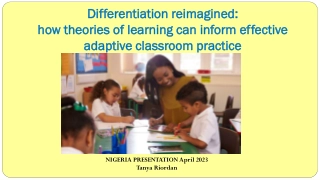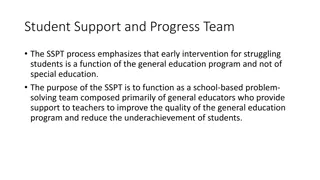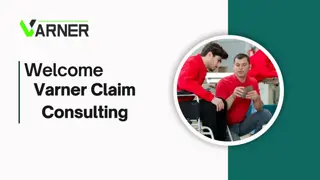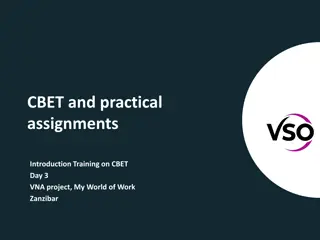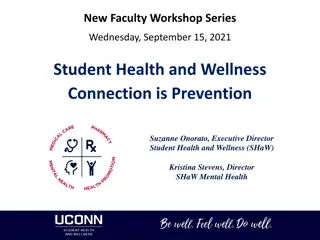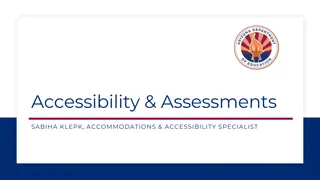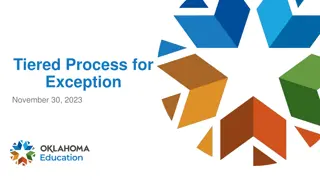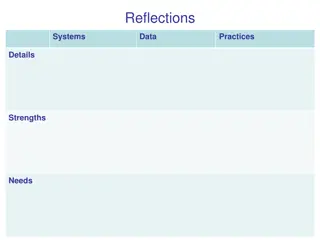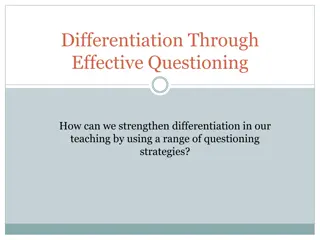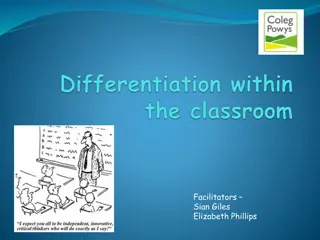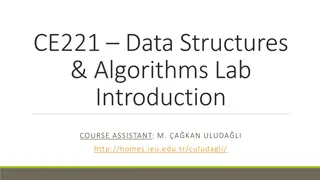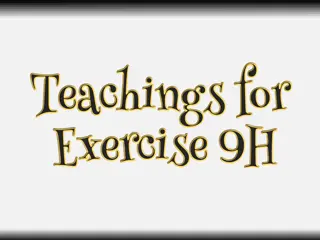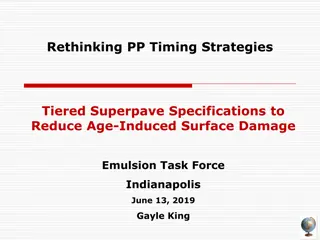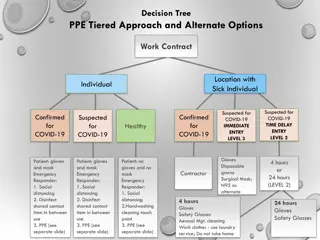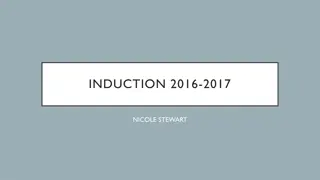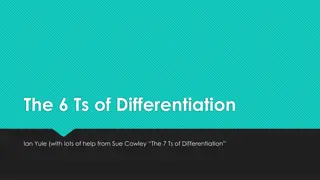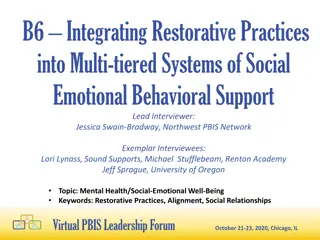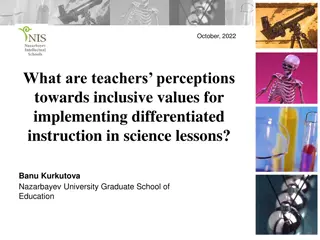Understanding Tiered Assignments for Effective Student Differentiation
Explore tiered assignments as a form of differentiation in education, providing multiple levels of tasks to meet students' varied readiness and interests. Discover how tiering assignments can enhance learning outcomes by tailoring challenges and support to individual student needs across various tasks.
Download Presentation

Please find below an Image/Link to download the presentation.
The content on the website is provided AS IS for your information and personal use only. It may not be sold, licensed, or shared on other websites without obtaining consent from the author. Download presentation by click this link. If you encounter any issues during the download, it is possible that the publisher has removed the file from their server.
E N D
Presentation Transcript
Tiered Assignments: Creating Levels for Student Work
Please visit the graffiti wall. Use a black marker and write one or two things you know about a particular term or concept.
Outcomes As a result of this session, participants will be able to Define tiering and associated terminology Identify important aspects and concepts of tiering Consider options for tiering assignments
20040722-14%2520-%2520VA%2520Trip%2520-%2520Stairs%2520in%2520Cape%2520Hatteras%2520Lighthouse,%2520NC20040722-14%2520-%2520VA%2520Trip%2520-%2520Stairs%2520in%2520Cape%2520Hatteras%2520Lighthouse,%2520NC What is Tiering? A form of differentiation where: Two or three levels of the same assignment are presented Levels differ in depth and complexity Students have the opportunity to actively learn the SAME concept 20040722-14%2520-%2520VA%2520Trip%2520-%2520Stairs%2520in%2520Cape%2520Hatteras%2520Lighthouse,%2520NC 20040722-14%2520-%2520VA%2520Trip%2520-%2520Stairs%2520in%2520Cape%2520Hatteras%2520Lighthouse,%2520NC stairs-to-heavenuphere stairs-to-heavenuphere stairs-to-heavenuphere stairs-to-heavenuphere stairs-to-heavenuphere
minilockedbox Tiering is A form of differentiation Differentiation according to readiness, MI, or learning styles Based upon students readiness or interest for a particular task Driven by pre- assessment NOT the only kind of differentiation, though it is foundational NOT locking students into ability boxes -- groups are flexible and vary according to the task NOT more work or better work for some levels tasks are equitable
When tiering assignments, a teacher Selects learning goals Pre-assesses students grasp of those goals Designs several equally respectable tasks To meet those same learning goals With varying degrees of challenge and support Infuses challenge and support into the task s Content (What the students learning about?) Process (What level of thinking is required?) Product (How will the results of the learning be represented and assessed?)
Key Principle: Tiering relies on information gathered about students readiness to deal with specific things they need to know, understand, and be able to do.
To Tier,,,,or ( you know how it goes,,,) When some students need additional time to master a skill or content When activities can be matched by resources and readiness When outcomes can be achieved through basic and advanced work When outcomes can be demonstrated in more than one way Start with a task and work your way up,,,,,, What do you want your students to know and be able to do?
Tiered assignments are usually created based on Student Readiness for a Skill Pre-assessment determines level of readiness Tiers reflect differences in critical thinking level or complexity Multiple Intelligences or Learning Styles Tiers reflect differences in interest or learning preference
When tiering, you should be teaching the same objectives to all students, content mastery should take the same amount of time, and, most importantly, each student should be challenged to do his/her best at whatever level he/she is performing. We all need to have respectful tasks and be challenged!
Respectful Tasks are Different not more or less Equally active Equally interesting and engaging Fair in terms of expectations and time
Sample Exit Card: Science Name: What is mitosis? Briefly explain the process of mitosis. How does the process of mitosis connect with the rest of this unit?
Exit Card Groupings Group 2 Students with some understanding of concept or skill Group 1 Students who are struggling with the concept or skill Group 3 Students who understand the concept or skill Readiness Groups
Features of Tiered Lessons Based on Readiness Struggling Learners Knowledge and comprehension levels of thinking for independent work Includes supportive strategies Converges on right answer to solve problem (more closed-ended) Less difficult independent reading Spare text, more graphic aids Fewer steps to complete Very concrete
Average Learners On-grade level reading materials More steps Concrete concepts used to transition to more abstract ones Knowledge, comprehension, and application levels of thinking for independent work, higher levels with help Assumes more inferencing and drawing conclusions with less teacher support Mix of right and open-ended answers
Advanced Learners More complex reading materials More steps or more lengthy materials since can read faster Abstract concepts as much as possible Analysis, synthesis, and evaluation levels of thinking Requires inferencing drawing conclusions, and evaluating Open-ended questions almost exclusively
Tiered Lessons Based on Learning Style, Multiple Intelligences Gardiner s Multiple Intelligences Verbal/Linguistic Logical/Mathematical Visual/Spatial Bodily/Kinesthetic Musical Interpersonal Intrapersonal Naturalist Learning Styles Visual Auditory Kinesthetic/Tactile
CONTENT + PROCESS + PRODUCT = THE LEARNING EXPERIENCE Examine the issues surrounding the use of the atomic bomb during WW II. Establish your position for or against, and compose a convincing argument to be presented in a point/counter point dialogue. Adapted from Differentiating Instruction in the Regular Classroom - Heacox
Be consistent. Be sure everyone knows the rules in advance and that they are presented in clear, written form.
From Theory to Practice English 10 Amon Colburn
Reflection Think about a lesson or learning activity that you have recently implemented and ask yourself the following: Did some of my students need more time to achieve mastery? Could the outcomes been demonstrated by students in more than one way? Using the Tiered Lesson Plan Template Draft one or two learning activities that support the objective. Activities can reflect readiness or learning style.
Next steps Think about a unit for next semester where tiered assessments can be incorporated. Consider collaborating with course alike colleagues to develop tiered learning activities.
Do you. Have additional questions or concerns that you would like to discuss? Need help locating additional resources? Need another pair of hands to get the job done?
Nowrevisit the graffiti wall, and use a purple marker to add any new terms, concepts, or reflections that you have acquired as a result of this session.
Additional Resources http://www.learnerslink.com/curriculum.htm http://www.bertiekingore.com/tieredinstruct.htm http://www.saskschools.ca/curr_content/bestpractice/tie red/index.html http://www.manhattan.k12.ca.us/staff/pware/diff/ http://www.doe.state.in.us/exceptional/gt/tiered_curricul um/welcome. http://www.uhseport.net/published/k/sh/kshaw/collectio n/1/


